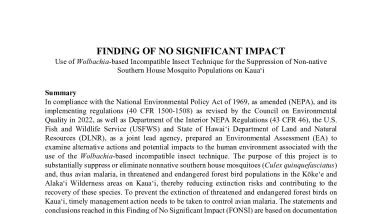
In compliance with the National Environmental Policy Act of 1969, as amended (NEPA), and its implementing regulations (40 CFR 1500-1508) as revised by the Council on Environmental Quality in 2022, as well as Department of the Interior NEPA Regulations (43 CFR 46), the U.S. Fish and Wildlife Service (USFWS) and State of Hawaiʻi Department of Land and Natural Resources (DLNR), as a joint lead agency, prepared an Environmental Assessment (EA) to examine alternative actions and potential impacts to the human environment associated with the use of the Wolbachia-based incompatible insect technique. The purpose of this project is to substantially suppress or eliminate nonnative southern house mosquitoes (Culex quinquefasciatus) and, thus avian malaria, in threatened and endangered forest bird populations in the Kōkeʻe and Alakaʻi Wilderness areas on Kauaʻi, thereby reducing extinction risks and contributing to the recovery of these species. To prevent the extinction of threatened and endangered forest birds on Kauaʻi, timely management action needs to be taken to control avian malaria. The statements and conclusions reached in this Finding of No Significant Impact (FONSI) are based on documentation and analysis provided in the EA. Relevant sections of the EA are summarized and incorporated by reference below. Although the EA was a cooperative federal and state compliance document satisfying both NEPA and the Hawai‘i Environmental Policy Act (HEPA) regulations, this FONSI analyzes only the impacts under current NEPA standards.

